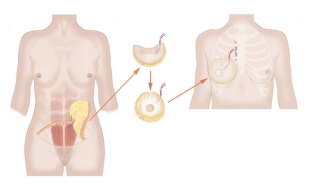Use of skin grafts – it is an excellent method of closing wounds of various localization on the human body. Different situations can serve as the cause of their occurrence: surgical removal of neoplasms, mechanical damage and burns. When the size of the wound is such that it is not possible to suture it – skin grafts are an excellent solution to this problem. But in different areas of the human body, the skin has its own characteristics, which must be taken into account before transplantation. What are the main donor areas for skin grafts can be identified in the human body – read today at estet-portal.com.
Skin graft collection sites for different recipient areas
The skin of different areas of the human body differs in its color, degree of hairiness, blood supply and structure in principle. In modern plastic surgery, there is an unspoken rule: the closer the donor area is to the recipient area, the more suitable the skin graft will be for transplantation. For example, grafts from the supraclavicular region retain their natural pink color when transplanted to the face, while grafts from the infraclavicular region acquire a yellowish or brownish tint over time. Thus, according to the wound in which area of the body needs to be closed, there are several main suitable places for taking grafts.
Transplant:
- places for taking grafts needed to close wounds on the face;
- what grafts can be taken from the abdominal wall, thighs and buttocks;
- hand, scalp and labia: how grafts from these areas are used.
Locations for taking grafts needed to close facial wounds
To close various wounds in the facial area, it is best to use skin grafts from the following sites on the patient's body:
- behind the ear – this space and the mastoid region adjacent to it is considered to be the optimal site for taking full-thickness skin grafts, ideally matching the skin of the face;
- anterior area – the skin in this area practically does not differ in color from the skin of the face, and can also be used as a transplant. From the anterior region, without tension, it is possible to take a skin area up to one centimeter wide;
- supraclavicular region – the skin of this zone allows both split and full-layer skin grafts to be taken for transplantation to the facial area. Often, the skin of the supraclavicular region is preferred in cases where it is necessary to close a large wound, for example, a defect on the entire forehead, nose, chin, cheek or upper lip.
Which grafts can be taken from the abdominal wall, thighs and buttocks
The patient's anterior abdominal wall, thighs, and buttocks are often used to harvest split skin grafts and close large wounds. The sampling of such grafts, if possible, should be made from areas that can be hidden as much as possible by underwear, bathing suits or light clothing. It is also important that the patient's pubic hairs do not get into the graft area. When working with such transplants, one should take into account some of their features, for example, the fact that over time the skin of these areas can change its color, becoming yellowish or brownish. Pigmentation is also significantly enhanced by exposure to ultraviolet rays, which should be warned in advance.

Hand, scalp and labia: how grafts from these areas are used
Skin grafts from the elbow joint and inguinal folds are well suited for closing defects of the fingers, as well as some defects of the hand. To prevent hair from growing from a transplant taken from the inguinal region, it is necessary to take it from the lateral sections. The skin of the hands is also well suited for closing various finger defects. The skin of the scalp is widely used for the treatment of post-burn injuries: the color of the skin in the area of the scalp almost perfectly matches the color of the skin of the face. Very often, women who need breast reconstruction after its removal turn to plastic surgeons. For the reconstruction of the nipple and areola in such cases, grafts from the region of the labia majora, as well as a part of the areola from the preserved mammary gland are often used.<







Add a comment